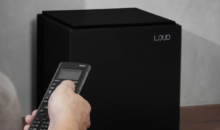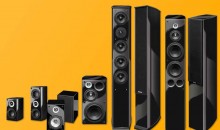What is a Subwoofer? Demystifying the Big Black Box
For many of us, a subwoofer is not much of a mystery. We understand its uses and perhaps even have one or two in our homes already. I’m not writing this article for those of us “in the know”. This article is for those who are new to home theater, people who may be starting out with their first AV system, or even those who simply take these black boxes for granted and want to know a little more about how they tick. And we’ll talk about it all: how they’re made, types of subwoofer designs, the differences between using a sub for home theater and music…even why size really does matter. So if you’ve ever asked “What is a subwoofer?” this article is for you.
The Mechanics of a Subwoofer
A subwoofer really is just a big, usually black, box. But it’s a sophisticated black box—with moving parts, multiple major components, and a whole lot of engineering that goes into making something play down low without sounding like an elephant suffering from emphysema. If you break down a sub, you find several things:
- The Enclosure
This is the “black box” (or white, or other colors) that houses all of the components. The shape and size of this box help “tune” the output of the sub. It determines, among other things, how low the sub plays, where its strongest frequency band is, and how much output (measured as dB SPL—or decibels of sound pressure levels) is possible. This enclosure may be sealed or ported (more on that later) and it may house one or more drivers. The quality of the enclosure is important for many reasons, but the chiefest is that you want all of the sound emanating from a subwoofer to come from the driver(s) and port(s)—not from “leaky” gaps in the edges or corners of the cabinet. - The Driver, or “Woofer”
This is the “piston” or loudspeaker driver that creates the sound waves from the enclosure. There may be one more of these drivers in a single cabinet, and one or more may even be serving as “passive radiators” which produce additional sound in response to the active driver. The drivers vary in size, but a general rule is that the larger the surface area of the active drivers, the deeper the subwoofer can play. There are exceptions to this rule, so don’t treat that as an absolute, but—in general—a 12″ subwoofer will tend to play lower than an 8″ woofer, all other things being relatively similar. Drivers can be made of aluminum, composite or coated paper, or some type of graphite material. The idea is to have a driver that is stiff and which moves with very little flexibility so that the sound comes out cleanly from the surface area presented. Other parts of the driver include the surround, which attaches the moving part of the woofer to the frame; the voice coil, which transmits the electrical energy to produce the forces to move the woofer; and the magnet, which serves as the largest part of the “motor” section o make the driver move back and forth. Generally, a larger magnet structure will indicate a more powerful and capable driver.
- The Port(s) or Passive Radiator(s)
Ports and passive radiators essentially do the same thing—just differently. They deal with excess pressure produced by the push and pull of the driver within the enclosure. A port allows air to travel both in and out, and allows a subwoofer to play back lower frequencies at a higher output (louder) than would otherwise be possible if the enclosure were completely sealed. Similar to a port, a passive radiator also relieves pressure while allowing for additional sound to be released from the surface of the non-powered woofers. The result is greater output. - The Amplifier
Most subwoofers have a Class-D amplifier, and some use what’s called a BASH amp, a proprietary design that seems to work really well. Still, others use a traditional Class AB amplifier. The differences aren’t really important, and one is hardly better than another. It’s more of a difference in design philosophies between various manufacturers. What you want to make sure of, is that your subwoofer has enough power. A “starter” subwoofer typically has 100W of power, but more serious home theater enthusiasts will want something with a bit more headroom (reserve power for peaks). A larger driver, with a larger cabinet and higher SPL output, will typically require more power as well. While most home theater subwoofers are “active” (the amplifier is located within the enclosure), some subwoofers are passive, with external amplifiers that connect to speaker terminals on the subwoofer. Most obvious is the in-wall sub, which requires an external amplifier in order to function correctly within a wall cavity.
There are other parts of a subwoofer as well, including connections and EQ circuits. Some of you who build your own products with subwoofer kits will be wondering why I didn’t go into further detail. The truth is that, for now, I want to keep things simpler in order to reach a wider audience with the basics.
Types of Subwoofer Designs
There are currently three types of subwoofer designs on the market, with multiple variations. They can be broken down into how the driver interacts with the cabinet. Here are the three designs that define what a subwoofer can be classified as:
- Sealed Subwoofers (also called acoustic-suspension or air-suspension)
This is your traditional subwoofer. You have a sealed box with a single hole for the driver/woofer and an amplifier installed in the back (some amps are external, but for purposes of simplification, we’ll assume powered subs). All of the sound pressure (output) of a sealed sub comes from the woofer—which can be oriented towards the front or even at the ground (these are called “down-firing” subs). The air inside the box is “trapped” and compresses and decompresses with the motion of the driver. A sealed subwoofer tends to lose frequencies more gradually at the bottom end than a ported subwoofer. - Ported Subwoofers (also called bass-reflex)
Ported subwoofers use a tuned port to increase the output of the subwoofer by allowing more energy to emanate from the port in addition to the woofer. Because of really bad designs on the market, many people will argue that a sealed enclosure is better for music, and ported designs allow for more output to handle the peaks of movies. That may be a general rule of thumb on the part of greater output, but a well-designed ported sub can play flat and have low distortion for audiophile music applications. The key phrase is that the sub must be “well-designed.” A good ported design will have, among other things, something that diffracts air as it moves through the port. This can be flouting or dimples in the port, or flared ends that disperse air more widely as it exits on either side. A ported sub does make it easier to produce higher output, so you will see these subs tending to have higher output (dB SPL) levels than their ported counterparts until you get up in top much larger sizes and more expensive designs. - Passive Radiator (also called bass-reflex)
Substitute a passive radiator (driver/woofer) for a port and you have the same basic design, just one that uses a flat driver or woofer without its motor structure. Ported designs engage in a delicate balance that includes air volume, the port or passive radiator’s resonant tuning, and the characteristics of the driver(s) used in the design.
Technically, a fourth design exists (plus, you can pretty much combine ported subs and passive radiators) and that is the band-pass design. This design is used mostly in pro audio installs and car audio as opposed to home theater, but it does show from time to time. A band-pass design takes a driver and places it fully within the cabinet—it doesn’t fire directly into the room at all. Instead, the woofer outputs into a tuned chamber that literally blocks the higher frequency output of the driver and only allows the desired frequency range to escape. This type of subwoofer is incredibly powerful, flexible…and totally subject to the design whims of the manufacturer. You can tune the enclosure, the chamber, and the port—all three factors making it very difficult to nail down any generalities on this type of design.
What is a Subwoofer for Home Theater?
For home theater, a subwoofer provides that low-frequency “kick” that puts the power into a gunfight, the awe into an explosion, or the eeriness into the ambiance of a sci-fi thriller. You want a subwoofer that can be “felt.” Smaller boxes that come with soundbars and home-theater-in-a-box kits can add a lot of low end to a movie or soundtrack, but if you don’t “feel” your sub, then you can stand to upgrade. When people ask me what a subwoofer is good for in regard to home theater, I tell them it’s the most important speaker in the room next to the main left and right channels. A good center channel can improve dialogue. A good subwoofer can make your friends’ jaws drop or cause you to clutch the arm of your chair. For home theater, a subwoofer is necessary. Buy it first.
What is a Subwoofer for Music?
If you have a pair of truly full-range tower speakers (hint: you likely don’t) you may belong to a small group of individuals who desire music purity. If, however, your main speakers don’t go down to 20Hz, then they aren’t truly full-range and you’re missing some of the finer details in orchestral scores, rock and pop music, and most definitely soundtracks. A good subwoofer gives you the punch in a kick drum, the deep resonant tone in a cello, and the satisfying extension of an electric or acoustic bass. If you’re listening to music with a bottom frequency limit of 40-55Hz, you’re not getting all of the sound that’s recorded on your music. This goes double for high-resolution audio tracks. A subwoofer or two will increase the fidelity and realism of your favorite music. If you want to hear all of your music, you’ll want a sub.
What a Subwoofer Isn’t
I’ve told you what a subwoofer is, now I want to make sure you’re not fooled by imitations. A subwoofer is not a “bass module.” If your subwoofer doesn’t go down to at least 40Hz, then you’re really just getting a device that produces some lower frequencies to round out the frequency response of your other speakers or a soundbar. There’s nothing wrong with that—it’s just not the type of subwoofer we’ve been discussing. Also, that type of bass module will often try to play lower frequencies. They can’t, but they’ll try. And that attempt can create distortion and noise that can make things sound worse.
A true subwoofer is going to go down to 35Hz or lower and it will have enough volume and output to fill your room. You may, in fact, need two subs (we actually recommend it). A subwoofer pressurizes a room in order to put out sound at a level that is tactile and “felt.” That’s the kind of sub that really brings your music and movies alive. Don’t settle for anything less.
A subwoofer isn’t an inconvenience. While you can hide it away easily enough, don’t base its placement solely on the fact that you don’t want it seen. Placing a subwoofer in an unused fireplace may seem like a neat idea, but pay attention to how it sounds at the listening position. Sticking it in a corner has the same issues. You may get more output, but it may sound really awful in your favorite chair or sofa. Placement matters. For more ideas on subwoofer placement check out our linked article.








Hi Clint, I found your article to be a valuable source of information. Great share!